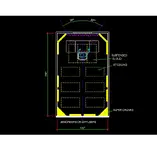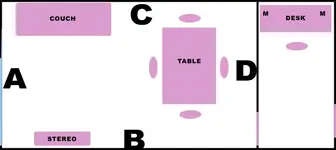Hello Jeff K and welcome to the bbs. Well, I assume you know that "soundproofing" is out of the question, and you are only interested in treating for acoustical quality. I do have a couple of things you need to clarify.
First off, on the glass wall, what exactly is this made like. I mean, I wouldn't think the glass is floor to ceiling, nor would I think it is wall to wall. Can you post a plan view drawing of the building showing the glass, and the door, with fairly accurate dimensions?
Second, as to the 9' ceiling. Is this a flat ceiling? If not then 9' doesn't make sense. If it is a pitched gable roof, what is the height at the roof/wall intersection, and what is the height to the ridge?
Since this is a metal building, and you're primary interest is mixing, bass frequencies will transmit directly to the outside world, so little bass trapping will be necessary. If you monitor at high SPL(volume) I hope your location isn't close to neighbors as you have virtually nothing to stop sound transmission to the outside world. Treatment will do nothing for it either. It will only affect the quality of the sound inside. However, if you are not concerned with sound escaping, then this is to your benifit as you will not have to absorb bass frequencies as much.
For your situation the bottom line is BROADBAND absorption. Your entire budget should be applied to this approach. But your budget will still determine the amount of absorption you can apply. As a minimum, I would purchase at LEAST, 12 panels of RIGID FIBERGLASS. Preferably 24-36 panels. These come in different thickness and are priced accordingly. The panels are usually 2'x4' and come in thickness's of 1", 2", 3" 4" and 6". The thickness will determine the low frequency cutoff of the absorber. Allowing an airgap behind the panels will also lower the bandwidth of absorption. There are TONS of threads describing this and how to cover the panels with fabric. Just do a search. Diffusion should also be used at ther rear wall, but we'll approach that later.
Your best option is to treat your room for a reflection free monitoring position. However, the location will still be determined by a couple of factors, such as door placement and type(sliding or hinged), and the nature of the glass wall(just a window or full glass wall). Also your speaker type and size will determine things also. Do you nearfield monitor or have speakers mounted on stands or use PA speakers or what?
IF the glass wall is a window centered on a 11 foot wall:
Orient your monitoring axis on the long dimension, with the window behind your monitors. This window can be either covered with a HEAVY drape of valoor or other heavy fabric OR a framed absorber made of a few of these panels.
As for the reflection free zone, the front of the room needs absorbers placed on the front corners, at the sidewalls adjacent to the engineering position. Use a small mirror to locate these, by sitting in the enginerring position and have someone hold a mirror on the sidewall. Move the mirror around untill you see a monitor in the mirror. As the mirror is moved and the monitor moves out of the reflection, mark this area on the wall The area that you can see the monitor is the area you should cover with an absorber.
Next is a "cloud" absorber hung over the engineering possition, and possibly a small throw rug in front, and a few on the floor behind. For general broad band absorption, a few panels spaced on the sidewalls and on a pitched cieling will help. The cloud should be a framed absorber with a 1/4" ply or mdf back with the fiberglass spaced off the back about an inch. Depending on location, other panels may need a back also. Take a look at the plan view below. This will help illustrate the placement.
Also, even though the building is metal and bass frequencies will escape, some bass absorption will be needed. I suggest the use of "superchunks" of 4" thick Owens Corning 703, from floor to ceiling in the rear corners, and even in the front corners if budget will allow. These are made by cutting panels in 2'x2' triangles from the panels. You will get 4 per panel. Stacking them will require 24 pieces, which is 6 sheets per corner. If budget doesn't allow for this many panels, simply stradle each corner diagonally floor to cieling with 2 panels.
This is why 24-36 panels would be a better choice, as it will
take 12 panels for the 2 rear superchunk corners alone. The other 12-24 could be placed as shown. The front corners will take a total of 4 panels. The side walls at the engineering position could possibly take 4 total, and the cloud could take 3, the rear side walls take possibly 6, the ceiling possibly another 6, the rear wall 2, although this wall could have diffusing elements placed against it. So, for a total of say 36 panels, at 8 sq. feet per panel, and roughly a dollar a square foot for 4", you're looking at roughly $300-$400 to properly treat this space.
Well, Im outta time, hope this helps as a beginning. If you are interested in more info, here are a couple of links to check out. The diffuser thing is quite complicated to describe here, but if your interested let me know. I'll try to explain later. Now, there are other ways to utilize these panels, but without knowing exactly what the building is like(pitched roof etc) I can't exactly say.
Although, the area within the pitched roof if exists could possibly be used for superchunk treatment or baffles even. But needless to say...without knowing.
Anyway, my disclaimer is in force as usual. ie...I'm no expert. BTW, ETHAN WINER IS!!

I just happened to type this just before he posted. Oh well!
fitZ


 I just happened to type this just before he posted. Oh well!
I just happened to type this just before he posted. Oh well!

 !
!